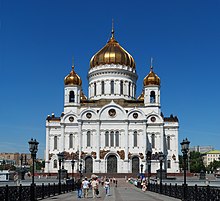Russian Orthodox Church (Moscow Patriarchate) | |
|---|---|
| Русская православная церковь | |
 | |
| Abbreviation | ROC |
| Classification | Eastern Orthodox |
| Orientation | Russian Orthodoxy |
| Scripture | Elizabeth Bible (Church Slavonic) Synodal Bible (Russian) |
| Theology | Eastern Orthodox theology |
| Polity | Episcopal |
| Governance | Holy Synod of the Russian Orthodox Church |
| Structure | Communion |
| Primate | Patriarch Kirill of Moscow |
| Bishops | 382 (2019)[1] |
| Clergy | 40,514 full-time clerics, including 35,677 presbyters and 4,837 deacons[1] |
| Parishes | 38,649 (2019)[1] |
| Dioceses | 314 (2019)[2] |
| Monasteries | 972 (474 male and 498 female) (2019)[1] |
| Associations | World Council of Churches[3] |
| Region | Russia, post-Soviet states, Russian diaspora |
| Language | Church Slavonic (worship), Russian (sermon and paperwork); in addition: languages of national minorities in Russia professing Eastern Orthodoxy; local languages in diaspora (first of all, English) |
| Liturgy | Byzantine Rite |
| Headquarters | Danilov Monastery, Moscow, Russia 55°42′40″N 37°37′45″E / 55.71111°N 37.62917°E |
| Founder | Vladimir the Great[4][a] |
| Origin | 988 Kievan Rus' |
| Independence | 1448, de facto[7] |
| Recognition |
|
| Separations |
|
| Members | 110 million (95 million in Russia, total of 15 million in the linked autonomous churches)[8][9][10][11] |
| Other name(s) |
|
| Official website | patriarchia.ru |
| Part of a series on the |
| Eastern Orthodox Church |
|---|
| Overview |
The Russian Orthodox Church (ROC; Russian: Русская православная церковь, romanized: Russkaya pravoslavnaya tserkov', abbreviated as РПЦ), alternatively legally known as the Moscow Patriarchate (Russian: Московский патриархат, romanized: Moskovskiy patriarkhat),[12] is an autocephalous Eastern Orthodox Christian church. It has 194 dioceses inside Russia.[13] The primate of the ROC is the patriarch of Moscow and all Rus'.
The Christianization of Kievan Rus' commenced in 988 with the baptism of Vladimir the Great and his subjects by the clergy of the ecumenical patriarch of Constantinople, which traditionally marks the beginning of the history of Russian Christianity.[14][15] Starting in the 14th century, Moscow served as the primary residence of the metropolitan,[16] and in 1448, the ROC declared autocephaly.[17] Later, in 1589, the metropolitan of Moscow was elevated to the position of patriarch with the consent of Constantinople.[18] In the mid-17th century, a series of reforms led to a schism in the Russian Church, as the Old Believers opposed the changes.[19]
The ROC currently claims exclusive jurisdiction over the Eastern Orthodox Christians, irrespective of their ethnic background, who reside in the former member republics of the Soviet Union, excluding Georgia. The ROC also created the autonomous Church of Japan and Chinese Orthodox Church. The ROC eparchies in Belarus and Latvia, since the fall of the Soviet Union in the 1990s, enjoy various degrees of self-government, albeit short of the status of formal ecclesiastical autonomy.
The ROC should also not be confused with the Russian Orthodox Church Outside of Russia (or ROCOR, also known as the Russian Orthodox Church Abroad), headquartered in the United States. The ROCOR was instituted in the 1920s by Russian communities outside the Soviet Union, which had refused to recognise the authority of the Moscow Patriarchate that was de facto headed by Metropolitan Sergius Stragorodsky. The two churches reconciled on 17 May 2007; the ROCOR is now a self-governing part of the Russian Orthodox Church.
- ^ a b c d "Внутренняя жизнь и внешняя деятельность Русской Православной Церкви с 2009 года по 2019 год". www.patriarchia.ru (in Russian).
- ^ "Доклад Святейшего Патриарха Кирилла на Епархиальном собрании г. Москвы (20 декабря 2019 года) / Патриарх / Патриархия.ru". www.patriarchia.ru (in Russian).
- ^ "Russian Orthodox Church (Moscow Patriarchate)". World Council of Churches. January 1961. Retrieved 25 December 2022.
- ^ Voronov, Theodore (13 October 2001). "The Baptism of Russia and Its Significance for Today". orthodox.clara.net. Archived from the original on 18 April 2007. Retrieved 12 July 2007.
- ^ Damick, Andrew S. "Life of the Apostle Andrew". chrysostom.org. Archived from the original on 27 July 2007. Retrieved 12 July 2007.
- ^ Voronov, Theodore (13 October 2001). "The Baptism of Ukraine and Its Significance for Today". orthodox.clara.net. Archived from the original on 18 April 2007. Retrieved 12 July 2007.
- ^ "Primacy and Synodality from an Orthodox Perspective". Retrieved 5 March 2015.
- ^ "Religions in Russia: a New Framework". www.pravmir.com. Archived from the original on 25 December 2012. Retrieved 25 December 2012.
- ^ "Number of Orthodox Church Members Shrinking in Russia, Islam on the Rise - Poll". www.pravmir.com. Archived from the original on 30 May 2013. Retrieved 25 December 2012.
- ^ "Russian Orthodox Church | History & Facts". Encyclopedia Britannica. 27 January 2024.
- ^ Brien, Joanne O.; Palmer, Martin (2007). The Atlas of Religion. Univ of California Press. p. 22. ISBN 978-0-520-24917-2.
- ^ "I. Общие положения – Русская православная Церковь". www.patriarchia.ru (in Russian). Retrieved 5 March 2015.
- ^ Hanna, Alfred. "Union Between Christians".
- ^ Shevzov 2012, p. 16.
- ^ Robson 2010, p. 1108.
- ^ Shevzov 2012, p. 17.
- ^ Shevzov 2012, pp. 18–19.
- ^ Shevzov 2012, p. 20.
- ^ Shevzov 2012, p. 22.
Cite error: There are <ref group=lower-alpha> tags or {{efn}} templates on this page, but the references will not show without a {{reflist|group=lower-alpha}} template or {{notelist}} template (see the help page).